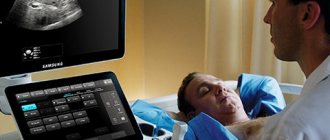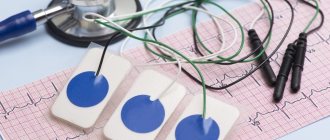Take the first step
make an appointment with a doctor!
Many women are faced with such a dangerous phenomenon as fetal bradycardia during pregnancy. This is an abnormal decrease in heart rate, which provokes insufficient saturation of the brain and other organs of the unborn child with oxygen. This could potentially lead to the death of the embryo or irreversible changes in its brain. How dangerous is fetal bradycardia, what factors contribute to its occurrence, and is it possible to reduce the risk? We will try to answer these questions in this article, also describing ways to solve this problem.
general information
Modern medicine does not identify a decrease in heart rate as an independent disease, but regards it as a symptom of certain pathological processes. As a rule, in children (including newborns) and adolescents, a sinus form of cardiac bradycardia is detected, which may also be accompanied by arrhythmia.
Assessing the presence or absence of pathology requires an integrated approach, since heart rate norms depending on age are only average values.
Symptoms of bradycardia in children
A mild form of sinus bradycardia in a child or adolescent does not cause any pathological symptoms.
The body tissues receive a sufficient amount of oxygen, so that the baby does not experience discomfort. With a significant slowdown in heart rate, signs of tissue oxygen starvation appear: fatigue, drowsiness, decreased performance at school, and forgetfulness. As the disease progresses, dizziness of varying severity appears, leading to falls and loss of consciousness. In this case, the skin becomes pale with a bluish tint, blueness appears around the mouth and cold, sticky sweat appears. As a rule, the attack lasts a few seconds. With constant bradycardia, fainting often occurs due to being in a stuffy room, stress, or physical overload.
Embryo 16 weeks - 19 weeks
During these three weeks, the fetus will noticeably increase in size and will be 22 cm in height, 240 g. in weight. During this period, the entire body will be covered with vernix lubrication, the glands begin to produce hormones, and the skeleton becomes much stronger. The lower part of the fruit begins to grow faster than the upper, that is, the proportions are equalized. Sex cells are formed in girls. This week may be accompanied by the first fetal movements. They won't be active at first, so don't worry if you don't feel your baby all the time.
Causes of bradycardia in children
Bradycardia is, first of all, a reaction of the heart to certain conditions. In this regard, the list of reasons that can cause such a problem is very long. The most important factors are:
- physiological: natural causes that do not indicate the presence of pathology;
- cardiac: associated with heart pathology;
- endocrine: associated with disruption of the endocrine glands;
- neurological: caused by a malfunction of the nervous system;
- intoxication: acute or chronic poisoning;
- genetic: hereditary pathology, for example, constitutional familial bradycardia;
- other reasons: gastrointestinal pathology.
Depending on the age of the baby, certain groups of factors predominate among the most likely causes.
Bradycardia in premature and newborn babies
A reduced heart rate at premature birth is physiological and is associated with the immaturity of heart rate regulation systems. With proper care and medication support, the condition gradually improves. The most common causes of bradycardia in a newborn child are heart defects, various types of encephalopathy, and birth injuries. Sometimes a pronounced decrease in heart rate indicates the development of transverse atrioventricular block (AV block). This is a dangerous condition that requires immediate medical attention.
Bradycardia in children of the first year of life (infants)
At this age, the pathological condition can be caused by the same reasons as in newborns. In addition, it is worth paying attention to the level of thyroid hormones. Hypothyroidism often causes a slow heart rate.
Bradycardia in preschool children
Bradycardia in a child aged 2 to 7 years is often associated with infectious diseases that are complicated by myocarditis - inflammation of the heart muscle. Poisoning and drug overdoses are also common at this age. The third common cause of bradycardia in a child aged 3–4 years and older is adenoids. Difficulty in nasal breathing leads to chronic hypoxia, causing a decrease in heart rate.
Bradycardia in schoolchildren and adolescents
A decrease in heart rate at school age may be due to the same reasons as in preschoolers, but they are accompanied by various types of gastritis and duodenitis associated with changes in diet.
Teenagers often encounter the manifestation of vegetative-vascular dystonia, which can occur according to the vagotonic type. A decrease in heart rate is accompanied by a drop in blood pressure, dizziness, and fainting. At the same age, autoimmune diseases and sick sinus syndrome often manifest.
Sinus bradycardia of the heart in adolescent athletes, which is not a symptom of the disease, stands apart. Regular intense exercise leads to the development of a physiological decrease in heart rate at rest, as the heart adapts to the additional work during exercise.
How does the human embryo develop?
Embryo at 1-2 weeks of pregnancy
In the first days, the follicle matures, from which the egg appears. It moves along the fallopian tube, where it meets the sperm. Fertilization occurs in which the 23 chromosomes of the egg combine with a similar number in the sperm. The sex of the unborn child depends on the presence of an X or Y chromosome in a male cell. Further along the course, the genome of the embryo is formed. On day 5, the embryo is ready to move into the uterus. There are cases when, after fertilization, the egg does not have time to reach the uterus, then an ectopic pregnancy occurs. Having reached the uterine region, the gastrula, which has transformed from the blastula, attaches to the walls. On day 9, the cells form a three-layer structure. As a result, the nervous system and skin will be formed from the outer layer. The middle layer will form the musculoskeletal system, muscles, blood vessels, internal organs, etc. The inner layer will create the cavity of the gastrointestinal tract. In the middle of the second week, a pregnancy test can already give a positive effect.
Embryo at 3 weeks of pregnancy
At week 3, cell division and growth into the uterine wall continues. At the same time, the formation of the umbilical cord and placenta begins, and amniotic fluid appears in the amniotic area. The size of the embryo reaches 4 mm.
Embryo at 4 weeks of pregnancy (1 month)
During this period, the heart begins to pump blood throughout the fetal body. The creation of the brain, spinal and head, from the neural tube begins. In addition, the initial stage of internal organs, eyes and limbs is formed. Nutrients were initially consumed from the yolk sac, and future reproductive cells also float in the yolk. From the end of the month, the functions of the pouch gradually weaken, and eventually it disappears.
Embryo. 5 weeks from fertilization
The fruit size is up to 2.5 mm and weighs 0.4 g. The development of the nervous system continues, sections for the stomach, brain, lungs, and trachea appear. The circulatory systems are expanding. At the same time, the mother develops drowsiness, nausea, and odor intolerance - the main signs of toxicosis.
The body's systems are rapidly developing: the neural tube is improving, future parts of the brain, lungs, stomach, trachea are being distinguished, blood vessels are growing. At this moment, the woman experiences signs of toxicosis: nausea, drowsiness, intolerance to certain odors.
Embryo. 6 weeks from fertilization
The embryo here looks like a “fry”. Its size is up to 6 mm. The brain is divided into hemispheres. The heart already has two chambers. It is already pumping blood, which is enriched with nutrients and oxygen. Limbs are forming. The excretory, respiratory, and digestive systems are formed. The placenta is formed, and amniotic fluid is around the embryo. The baby can already move in the shell. Pigment is acquired in the retina.
Embryo at 7 weeks of pregnancy
At this stage, the size of the embryo can reach 13-15 mm. Gaps appear between the fingers, although they are practically not developed. The head increases in size. Its body still has an arched shape, with a “tail” remaining on the pelvic part. The baby's breathing and nutrition come from the mother's blood. The pregnant woman’s belly is not yet visible, but urination becomes frequent due to an excess of fluid in the body.
Embryo 8 weeks
The dimensions are already about two centimeters. The face already looks like a human one - eyes, ears, lips and nose are distinguishable. The rudiments of the lungs, the digestive system, the heart, and the brain with two hemispheres have already been formed. Almost all the most important things have been formed. The bones are still in the form of cartilage.
Diagnosis of bradycardia in children
A pediatric cardiologist diagnoses bradycardia in children of any age. Its tasks include not only identifying the fact of a slow heart rate, but also searching for the cause of this condition, as well as selecting adequate treatment. In addition to a basic examination, listening to heart sounds, assessing pulse and measuring blood pressure, the examination includes:
- ECG;
- daily ECG monitoring (Holter);
- Ultrasound of the heart;
- stress tests: bicycle ergometry, treadmill test, atropine test;
- laboratory diagnostics: general blood test, assessment of hormonal status, etc.
Additional research and consultations may be aimed at finding a specific cause. Depending on the indications, an ultrasound scan of the thyroid gland and adrenal glands is performed, the content of electrolytes in the blood is assessed, etc.
Embryo 11 - 13 weeks
During this period, the expectant mother undergoes many different studies: ultrasound screening, ultrasound at 12 weeks of pregnancy. Screening allows you to identify various pathologies, abnormal structure of the body and organs, chromosomal abnormalities, etc. An ultrasound examination will give a 100% result in determining the sex of the child. The pancreas and liver are able to form secretions, the head is still disproportionate, and the child develops a thumb sucking reflex. The size of the fruit reaches 12-15 cm, weight - about 50 grams. All organs are formed, resistance to negative factors has appeared. The mother experiences heartburn, constipation and bloating instead of toxicosis.
Treatment of bradycardia in children and adolescents
Treatment of mild or moderate bradycardia and arrhythmia in a child of any age is aimed at normalizing the heart rate, as well as eliminating the cause of the pathological condition.
Depending on the situation, emergency medications and ongoing medications may be used to stabilize the heart. The choice of treatment method for bradycardia is made by a cardiologist. If a child develops severe bradycardia, accompanied by frequent fainting, Morgagni-Adams-Stokes attacks and other conditions that disrupt the usual rhythm of life, surgical treatment is used. Experienced cardiac surgeons implant an electrical pacemaker that controls the functioning of the heart. This treatment is also relevant if the condition arose against the background of severe defects and blockades.
Prognosis and prevention
The prognosis for bradycardia in a child depends on its cause and severity. In some cases, it is enough to adjust lifestyle or hormonal status to normalize heart function, while in others complex treatment and lifelong monitoring are required. Prevention of the development of pathology includes, first of all, teaching the child to a healthy lifestyle, prevention and timely treatment of diseases that can provoke this condition.
If your child or teenager is experiencing bradycardia, do not wait for the disease to progress; make an appointment with the pediatric cardiologists of the SM-Doctor clinic. You will receive a comprehensive examination, modern and effective treatment if necessary, as well as regular supervision by an experienced specialist.
Embryo 10 weeks
At the end of the 10th week, the size will be about 4 cm. The eyelids will close before the eyes; the baby will be able to open them himself at 7 months. The respiratory system is almost ready for use. The rudimentary tail disappears, and buttocks form in its place. The baby moves freely inside the uterine area.
The skeleton and its structure fully correspond to a person. The arms and legs become longer to the appropriate proportions. But the head will occupy almost half the length of the body. This is explained by the active development of the cerebral hemispheres, the cerebellum is growing. The external genitalia develop according to gender. You will soon find out if he or she is growing in your belly. The baby's blood acquires its own group and Rh factor.







